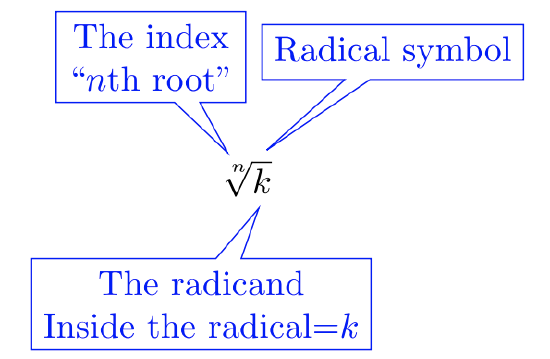6.1: Simplify Radical Expressions
( \newcommand{\kernel}{\mathrm{null}\,}\)
Who doesn’t love the “undo” command on a computer? Radicals are like an undo command to all powers. If taking powers is a forward-action, then radicals require us to think backwards. To prepare for this section, memorize the first twelve perfect squares and the first five cubes. It will be very helpful to recognize powers of 2 and 3.
Perfect Squares to memorize (first twelve):
1,4,9,16,25,36,49,64,81,100,121,144,…
Cubes to memorize (first five):
1,8,27,64,125,…
Let’s look at the anatomy of a radical:

| Index n | Example | Read Out Loud |
|---|---|---|
| Default Index n=2 | √4 | The square root of 4. |
| n=3 | 3√8 | The cube root of 8. |
| n=4 | 4√16 | The 4th root of 16. |
| n=5 | 5√32 | The 5th root of 32. |
The index, n, indicates the exponent of the related power.
√4=2Why? Because 22=4.3√8=2Why? Because 23=8.4√16=2Why? Because 24=16.5√32=2Why? Because 25=32.
All four examples above have a value of 2.
Simplify.
- √964
- 3√−64
- √−81
- 5√100000
Solution
- √964=38√964=38 because 38≥0 and (38)2=964.
- 3√−64=−43√−64=−4 because n=3 is odd and (−4)3=−64.
- √−81 is not a real number.No real number, when squared, equals −81.
- 5√100000=105√100000=10 because 105=100000.
The properties and examples (below) will involve a radicand with variables. From here on out, we will assume that all variables of even-indexed radicals are nonnegative values. That is, for n√xp and n is even, we will assume x≥0.
| Property | Examples |
|---|---|
| 1. n√an=a | 4√x4=x or 3√(−5)3=−5 |
| 2. Product Property: n√a⋅n√b=n√ab | 5√6⋅5√x2=5√6x2 or √100x4=√100⋅√x4=10x2 |
| 3. Quotient Property: n√ab=n√an√b | √x2100=√x2√100=x10 or 3√543√16=3√5416=3√278=32 |
Let m and n be integers such that m/n is a rational number in lowest terms and n>1. Then,
a1/n=n√a and am/n=n√am=(n√a)m
If n is even, then we require a≥0.
Write each expression in radical notation, then simplify.
- (81x2)−1/2
- (243)3/5
Solution
- (81x2)−1/2=1√81x2=19x
- (243)3/5=5√2433=5√(35)3=5√(33)5=33=27
Simplifying Radicals
Use as often as possible the property n√an=a to simplify radicals. Factor into chunks where powers equal the index n, then set those numbers or variable free from the radical! Again, you may assume in all problems that variables represent positive real numbers.
- √12x5y3
- 53√216u6v5
- −4√16a23
Solution
- √12x5y3=√12⋅√x5⋅√y3The product property: simplify 3 separate radicals.=√22⋅3⋅√x2⋅x2⋅x⋅√y2⋅yThe index n=2. Find powers of 2 to simplify.=√22⋅x2⋅x2⋅y2⋅√3xyGroup the squares. Group the non-squares.=2⋅x⋅x⋅y⋅√3xynSimplify using n√an=a.=2x2y√3xyCombine powers to simplify.
- 53√216u6v5=53√216⋅3√u6⋅3√v5The product property: simplify 3 separate radicals.=5⋅3√63⋅3√(u2)3⋅3√v3⋅v2The index n=3. Find powers of 3 to simplify.=5⋅3√63⋅(u2)3⋅v3⋅3√v2Group the cubes. Group the non-cubes.=5⋅6⋅u2⋅v⋅3√v2Simplify using n√an=a.=30u2v3√v2Combine powers to simplify.
- −4√16a23=−1⋅4√16⋅4√a23The product property: simplify 2 separate radicals.=−1⋅4√24⋅4√(a5)4⋅a3How many times does 4 go into 23 evenly? 5. R=3.=−1⋅4√42⋅(a5)4⋅4√a3Group powers of 4. Group non-powers of 4.=−1⋅2⋅a5⋅4√a3Simplify using n√an=a.=−2a54√a3Combine powers to simplify.
Multiply and simplify 3√4p2q3⋅3√6pq
Solution
3√4p2q3⋅3√6pq=3√4⋅6⋅p2⋅p⋅q⋅qThe product property consolidates the radical.=3√24⋅p3⋅q2Consolidate the powers using power properties.=3√23⋅3⋅3√p3⋅3√q2The product property: simplify 3 separate radicals.=−3√23⋅p3⋅3√3q2Group the cubes. Group the non-cubes.=2p⋅3√3q2Simplify using n√an=a.
Try It! (Exercises)
1. In Example 6.1.2b of this section, it is stated: 5√(35)3=5√(33)5.
Name the properties which allows us to equate (35)3=(33)5. Explain.
2. Use the equivalency xab=xba to simplify each of the following without using a calculator.
- 3√(73)10
- 4√(54)3
- 85√(−105)4
3. For each of the following, replace the stated number as a power of the index. Use the equivalency xab=xba to simplify each of the following.
For example: 3√85=3√(23)5=3√(25)3=25=32.
- √165
- −54√817
- −95√326
For 4-11, write each expression in radical notation, then simplify without a calculator.
- 121−1/2
- 322/5
- 125−2/3
- (−125)2/3
- (81100)1/2
- (64125)2/3
- (−64125)2/3
- (64125)−2/3
For 12-23, simplify the expression. Assume that variables represent positive real numbers.
- √18y3
- 3√250b5
- 4√48x9
- 5√−243c10
- −2a10√80a
- 3√500u545u
- 4√1250p9p13
- 34√96z206
- √128n10m3
- 4√405x14y65x4y
- (7√a5b6)35
- (3√8u6v126u2v)2
For 24-31, multiply and simplify. Assume that variables represent positive real numbers.
- −3x√5x⋅√20x3
- 2q3√54q2⋅3√4q4
- 6t3(4√75t6⋅4√100t3)
- 5√64u5v8⋅5√112v4⋅7v
- √5x10⋅√15x3x
- 12(3√18a22)(3√6a43a)
- 3√56n427m5⋅3√49m28n
- (24w1113)3(13w6)3


